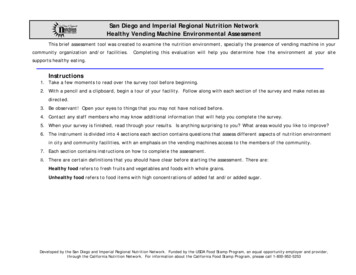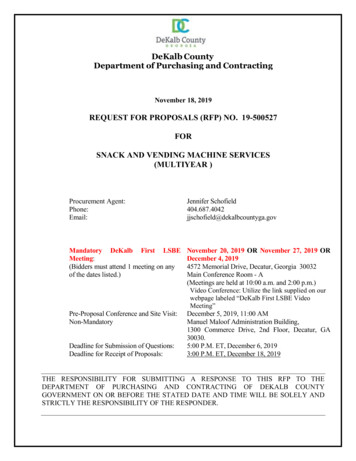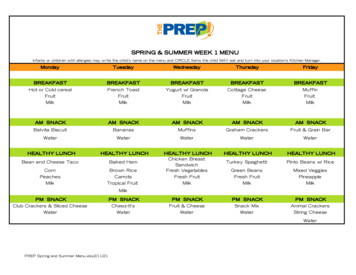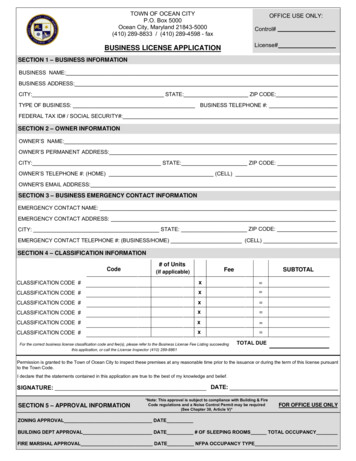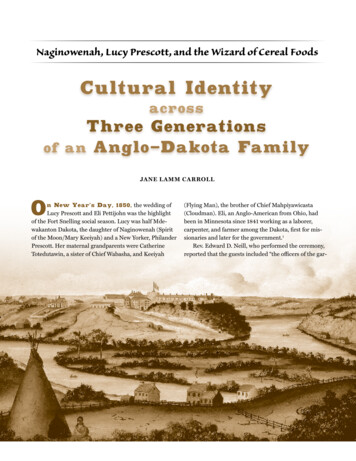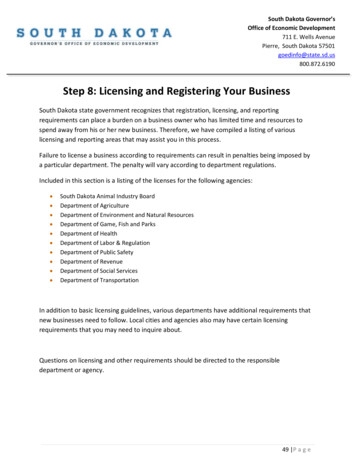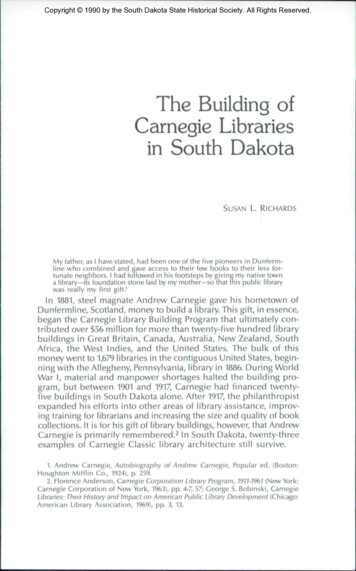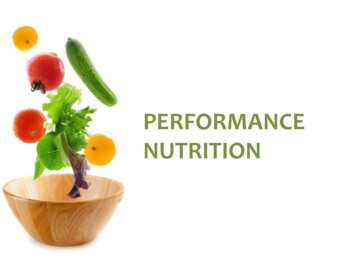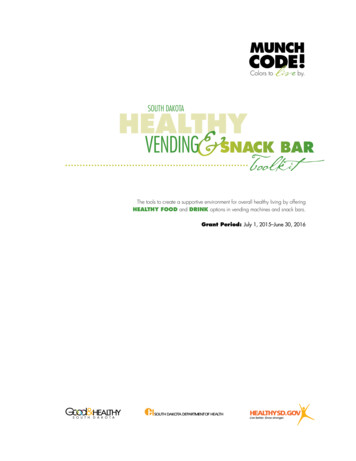
Transcription
MUNCHCODE!liveColors toby.SOUTH DAKOTAHEALTHYVENDING&SNACK BARToolkitThe tools to create a supportive environment for overall healthy living by offeringHEALTHY FOOD and DRINK options in vending machines and snack bars.Grant Period: July 1, 2015–June 30, 2016
TABLE OF CONTENTSModel Policy . . . . . . . . . . . . . . . . . . . . . . . . . . . . . . . . . . . . . . . . . . . . . . . . . . . . . . . . . . . . . . . . . . . . . . . . . 1Policy Implementation Guide . . . . . . . . . . . . . . . . . . . . . . . . . . . . . . . . . . . . . . . . . . . . . . . . . . . . . . . . . . 3Project Checklist . . . . . . . . . . . . . . . . . . . . . . . . . . . . . . . . . . . . . . . . . . . . . . . . . . . . . . . . . . . . . . . . . . . . . . 9Appendix AProject Plan Example . . . . . . . . . . . . . . . . . . . . . . . . . . . . . . . . . . . . . . . . . . . . . . . . . . . . . . . . . . . . . . . . . . . 11Project Plan Template. . . . . . . . . . . . . . . . . . . . . . . . . . . . . . . . . . . . . . . . . . . . . . . . . . . . . . . . . . . . . . . . . . . 12Appendix BVending Machine & Snack Bar Analysis . . . . . . . . . . . . . . . . . . . . . . . . . . . . . . . . . . . . . . . . . . . . . . . . . . . . . .Vending Machine Layout Option 1. . . . . . . . . . . . . . . . . . . . . . . . . . . . . . . . . . . . . . . . . . . . . . . . . . . . . . . . . .Vending Machine Layout Option 2. . . . . . . . . . . . . . . . . . . . . . . . . . . . . . . . . . . . . . . . . . . . . . . . . . . . . . . . . .Food Product Analysis Form. . . . . . . . . . . . . . . . . . . . . . . . . . . . . . . . . . . . . . . . . . . . . . . . . . . . . . . . . . . . . . .Drink Product Analysis Form. . . . . . . . . . . . . . . . . . . . . . . . . . . . . . . . . . . . . . . . . . . . . . . . . . . . . . . . . . . . . . .1315161719Appendix CVendor Letter. . . . . . . . . . . . . . . . . . . . . . . . . . . . . . . . . . . . . . . . . . . . . . . . . . . . . . . . . . . . . . . . . . . . . . . . . 21Appendix DStaff Survey . . . . . . . . . . . . . . . . . . . . . . . . . . . . . . . . . . . . . . . . . . . . . . . . . . . . . . . . . . . . . . . . . . . . . . . . . 22Appendix EStaff Taste Test. . . . . . . . . . . . . . . . . . . . . . . . . . . . . . . . . . . . . . . . . . . . . . . . . . . . . . . . . . . . . . . . . . . . . . . . 24Appendix FMaster Food & Beverage List . . . . . . . . . . . . . . . . . . . . . . . . . . . . . . . . . . . . . . . . . . . . . . . . . . . . . . . . . . . . . 25Appendix GVendor Contract Language. . . . . . . . . . . . . . . . . . . . . . . . . . . . . . . . . . . . . . . . . . . . . . . . . . . . . . . . . . . . . . . 26Appendix HSample Vending Machine Signage and Templates . . . . . . . . . . . . . . . . . . . . . . . . . . . . . . . . . . . . . . . . . . . . . . . 27Appendix IEmployee Email Example . . . . . . . . . . . . . . . . . . . . . . . . . . . . . . . . . . . . . . . . . . . . . . . . . . . . . . . . . . . . . . . . 31Appendix JFinal Progress Report Template. . . . . . . . . . . . . . . . . . . . . . . . . . . . . . . . . . . . . . . . . . . . . . . . . . . . . . . . . . . . . 32Technical Assistance Contact:Megan Hlavacek, MS, RDN, LNHealthy Foods Coordinator - Office of Chronic Disease Prevention & Health PromotionSouth Dakota Department of Health605-598-6277 Megan.Hlavacek@state.sd.usSOUTH DAKOTA HEALTHY VENDING & SNACK BAR TOOLKITi
HEALTHY VENDING AND SNACK BAR MODEL POLICYBUSINESS NAMEhas a commitment to provide an environment that encourages healthyeating habits among its employees and clients. The following policy has been developed to incorporate healthier food and drinkoptions in all vending machines and snack bars at allBUSINESS NAMElocations.The intent of this policy is to inform employees about what they are eating and which choices are healthier. It is designed tomake healthy choices more accessible, more appealing, and more affordable. It is not designed to restrict choices.BUSINESS NAMEwill provide employees with a variety of healthy food and drinkoptions by categorizing them as GREEN, YELLOW, and RED based on the standards outlined in the South Dakota HealthyVending and Snack Bar Policy Implementation Guide.GREEN foods/drinks are the healthiest option and can be enjoyed often.YELLOW foods/drinks have added sugar, fat, and calories and should be eaten occasionally.RED foods/drinks are the highest in sugar, fat, and calories and the least healthy. These foods should be eaten sparingly.All food and drink items will have the calorie content visible at the point of purchase. This includes food and drinks in each ofthe color-coded categories. A sign must be provided next to each item or in a visible location in close proximity to each food ordrink disclosing the calorie content. If the package contains more than one serving the workplace has the choice to disclose thecalories per serving including the number of total servings per package or calories per item.SOUTH DAKOTA HEALTHY VENDING & SNACK BAR TOOLKIT1
POLICY IMPLEMENTATION GUIDERationaleThe South Dakota Department of Health developed the Healthy Vending and Snack Bar Policy Implementation Guide to providebusinesses with guidelines for incorporating healthier food and drink options in vending machines and snack bars at theirworkplaces. This guide serves two purposes:1. Inform employees about what they are eating and which choices are healthier.(1)2. Increase choice, not restrict choice. The policy is designed to make healthy choices more accessible, more appealing,and more affordable. It is not designed to restrict choices.(1)Employers all across the country are working to create healthy work environments. Worksites have the opportunity to encouragehealthy eating habits and help prevent health problems such as diabetes, depression, and heart disease.(11) The consequencesof poor nutrition and obesity in the United States not only lowers the quality of life for individuals, but also reduces productivityand increases the cost of doing business.(8)The federal government has set an outstanding example by making healthy food and drink choices a priority in federal facilities.The U.S. Department of Health and Human Services (HHS) worked collaboratively with the General Service Administration(GSA) to create The Health and Sustainability Guidelines for Federal Concessions and Vending Operations.(4) The South DakotaHealthy Vending and Snack Bar Policy Implementation Guide was developed primarily from the HHS GSA guidelines, SouthDakota Healthy Concessions Policy, and the Nutritional Environment Measures Survey for Vending.(4,5,9)GuidelinesThis guide encourages the adoption of a color coded approach to choosing healthier items to offer in vending machines andsnack bars at your worksite. Rather than an ‘all or nothing’ approach, these guidelines categorize food and drinks as GREEN,YELLOW, or RED.GREEN foods/drinks are the healthiest option and can be enjoyed often.YELLOW foods/drinks may have added sodium and calories and should be eaten occasionally.RED foods/drinks are the highest in sodium, sugar, fat, and calories and the least healthy. These foods should beeaten sparingly.The guidelines have three main priorities: (2, 3, 4, 5, 9, 13)1. Establish clear guidelines for what constitutes GREEN, YELLOW, and RED foods based on trans-fat, sodium,calories, calories from saturated fat, and sugar.2. Establish clear guidelines for GREEN, YELLOW, and RED drinks based on calories per serving, fat content, additionof caloric sweeteners, and sodium content.3. Align with FDA (Food and Drug Administration) regulation to make the calorie content of ALL items visible at the pointof purchase. This includes both food and drinks. A sign must be provided next to each item or in a visible location inclose proximity to each food or drink disclosing the calorie content. If the package contains more than one serving theworkplace has the choice to disclose the calories per serving including the number of total servings per package orcalories per item.SOUTH DAKOTA HEALTHY VENDING & SNACK BAR TOOLKIT3
FOOD STANDARDSGREEN FOOD STANDARDSFoods must meet ONE of the core criteria: 2%, 1%, or fat-free dairy Whole, frozen, or dried fruits (including unsweetened applesauceand fruit cups packed in 100% juice or water) Whole or frozen vegetables Whole grain products (first ingredient is a whole grain) Plain nuts or seeds (can be flavored)Foods must ALSO meet ALL of the following: 200 calories or less per item* 230 mg of sodium or less per serving Zero trans fat (0.5 grams or less per serving) Total calories from saturated fat: 10% or less* Calories from sugar: 35% or less of total weight **YELLOW FOOD STANDARDSFoods do NOT need to meet one of the core criteria,but must meet ALL of the following: 250 calories or less per item* 480 mg of sodium or less per serving Zero trans fat (0.5 grams or less per serving) Total calories from saturated fat: 10% or less* Calories from sugar: 35% or less of total weight**RED FOOD STANDARDS Do not meet green or yellow standards*excluding nuts and seeds without added fats or oils**excluding fruits or vegetables without added caloric sweetenersSuggested Long Term Goal based on FederalFood Vending Standards (HHS/GSA Standards):At least 25% of foods will meet all of the green standards and100% of foods will meet the green trans fat and sodium requirements. Zero trans fat (less than or equal to 0.5 grams per serving) Snack items contain 230 mg of sodium or less per serving4GRANT PERIOD: JULY 1, 2015-JUNE 30, 2016
DRINK STANDARDSGREEN DRINK STANDARDS Water without flavoring, additives, or carbonation 2%, 1%, or fat-free unflavored milk, including lactose-free and soy drinks 12 oz. or less of 100% fruit or vegetable juice with no added caloric sweeteners and 230 mg of sodium or less per serving Decaffeinated and unsweetened coffee and tea (including herbal tea)YELLOW DRINK STANDARDS More than 12 oz. of 100% fruit or vegetable juice 2%, 1%, or fat-free flavored milk Diet soda Any other sweetened drink with 40 calories or less per 8 oz. (i.e. sports drinks, flavored water, sweetened tea, etc.)RED DRINK STANDARDS Regular soda and sports drinks Whole milk Fruit/juice drinks that are not 100% juice Any other drinks that do not meet the green or yellow standardsSuggested Long Term Goal based on Federal Beverage Vending Standards(HHS/GSA Standards):At least 50% of all drinks will be low calorie drinks (40 calories or less per serving), excluding 100% juice and unsweetened milk.Guide for Calculating Nutrition StandardsPercent calories from saturated fat:1. Multiply the grams of saturated fat by 9(there are 9 calories per gram of fat)1 gram saturated fatx 9 calories per gram9 calories from saturated fatNutrition FactsServing Size 2/3 cup (55g)Servings Per Container About 8As ServedAmount Per ServingCalories from Fat 40gCalories 230% Daily Value2. Divide the # of calories from saturated fat by the # of total calories9 calories from saturated fat 230 total calories0.0393. Multiply by 100 to equal the % calories from saturated fat0.039 x 100 3.9% calories from saturated fatTotal Fat 8gSaturated Fat 1g12%5%*Trans Fat 0gCholesterol 0mgSodium 160mgTotal Carbohydrate 37gDietary Fiber 4gSugars 1gProtein 3g0%7%12 %16 %Percent sugar by weight:1. Divide the # of grams of sugar by the total grams(total grams is listed in parenthesis after the serving size)1 55 0.0182. Multiply by 100 to equal the % sugar by weight0.018 x 100 1.81% sugar by weightSOUTH DAKOTA HEALTHY VENDING & SNACK BAR TOOLKIT5
IMPLEMENTATIONBusinesses may face certain barriers that affect their ability to offer healthier food and drink items, such as difficulty negotiating withvendors to include healthy items or limited sales of healthy items. Consider the following strategies to overcome these barriers: Negotiating with vendors: (9)·· Vocalize the desire for healthy food and drink options to be added to the vending machine and snack bar.·· Provide a copy of this guide to show the GREEN, YELLOW, and RED nutrition standards.·· State the number of GREEN, YELLOW, and RED items that are to be made available in each site. Sales maystart out slow for healthier options, but will increase over time.·· Discuss ways to label the items as GREEN, YELLOW, and RED.·· Discuss ways to make the calorie content of ALL items visible at the point of purchase.·· Discuss product placement and prices. Suggest reducing the cost of healthy food options and discuss any profitabilityconcerns the vendor may have. Enhancing sales of healthier items: (6)·· Pricing: Pricing strategies can be used to promote healthier foods and drinks. Have a meeting with the vendorsto talk about ways to keep prices for healthier items such as bottled water and fruit equal to or less than the price ofsoda or candy.·· Point of Purchase Information: Identify healthier options versus less healthy items through signage andpromotional materials. Develop signs to be placed near the vending machine, hang posters throughout the building,or place table tents in your cafeteria or break room.·· Product Placement and Attractiveness: Place your GREEN and YELLOW items at eye level and alongthe right hand column of the vending machine.(7)·· Taste Testing: Have the worksite wellness committee conduct a taste test of some of the GREEN and YELLOWfood and drink options that could be purchased through your vendor. This will help to determine which items have thebest sales potential.COMPLIANCEThere are many interpretations when classifying food and drinks as healthy or less healthy. This tool is a guide to assistbusinesses in implementing a policy that will fit their business and benefit their employees. A worksite wellness committee maybe the perfect group to ensure these guidelines will remain a priority.CONCLUSIONA first great step in creating a healthy nutrition environment for all employees is to utilize the implementation guide in its entiretyor choose to adapt the guidelines to meet the needs of the worksite.6GRANT PERIOD: JULY 1, 2015-JUNE 30, 2016
HOW TO USE THIS TOOLKITThis toolkit has been formatted as an editable PDF. It is best viewed in Adobe Reader, which is available to download for free atget.adobe.com/reader. Although many web browsers (Internet Explorer, Chrome, Firefox, etc.) have built in PDF-viewers,it is recommended that this file be downloaded to your hard drive or portable media device (USB/jump drive) and opened with Adobe Reader for full editability.Throughout this document you will find tables with fillable fields for your use and convenience. For helpful form field usage tips,hover your cursor over the field for a moment and a tooltip will pop up:There are also sample letters, surveys, and other text that you may find helpful as you work to create a healthiervending and snacking environment. Look for the ”copy & paste” icon and feel free to transfer to yourletterhead or business documents.SOUTH DAKOTA HEALTHY VENDING & SNACK BAR TOOLKIT7
DEFINITION OF TERMS Calories: A unit of measurement representing the amount of energy food and drinks provide when eaten to fuel our body Packaged Food Choices: Includes any processed, pre-packaged foods Whole Grain: Contains 100% of the original kernel. All of the bran, germ, and endosperm must be present to qualifyas a whole grain. Tip: Look for the word “whole”. Examples: (12)·· Whole wheat·· Whole corn·· Whole oats·· Whole grain [name of grain]·· Brown Rice·· Wild Rice·· Wheatberries·· Amaranth·· Barley·· Buckwheat·· Millet·· Quinoa·· Rye·· Sorghum (also called milo)·· Teff·· Triticale Fat-Free Milk (Skim): Non-fat milk with 0-0.5% fat by weight 1% Milk: Low-fat milk with 1% fat by weight 2% Milk: Reduced-fat milk with 2% fat by weight Whole Milk: 3.5% fat by weight Caloric Sweeteners: Provide energy (calories) in the form of carbohydrates. Also known as nutritive sweeteners or sugar.Note: Caloric sweeteners are not the same as artificial sweeteners such as aspartame, saccharin, stevia, and sucralose. (10)RESOURCES1. Concessions and Cafeterias: Healthy Food in the Federal Workplace. US General Services Administration. 2014.http://www.gsa.gov/portal/content/1044292. Diet and Lifestyle Recommendations Revision 2006: A Scientific Statement from the AmericanHeart Association Nutrition Committee. American Heart Association Circulation. full.pdf3. Dietary Guidelines for Americans 2010. US Department of Agriculture and US Department of Health and HumanServices. 2010. www.dietaryguidelines.gov4. Health and Sustainability Guidelines for Federal Concessions and Vending Operations. Health and Human Services(HHS) General Services Administration (GSA). 2012 http://www.cdc.gov/chronicdisease/pdf/guidelines for federal concessions and vending operations.pdf5. Healthy South Dakota – Model Concessions Policy. South Dakota Department of Health. 2010.http://healthysd.gov/link healthy-south-dakota-concessions-model-policy-116. Healthy Vending Guide. Nemours Health and Prevention Services. 2010. ng.pdf7. HYBRID TRAINING: Nutrition Standards TA Call Follow-up Webinar. Centers for Disease Control & Prevention. Recorded02/03/2014.8. Lead by Example: The Value of Worksite Health Promotion to Small and Medium Sized Employers. Partnership forPrevention. 2011. http://www.prevent.org/data/files/initiatives/lbe smse 2011 final.pdf9. Nutritional Environment Measures Survey – Vending (NEMS-V). Iowa Department of Public Health. 2014.http://www.nems-v.com10. Nutritive and Nonnutritive Sweetener Resources. US Department of Agriculture - National Agriculture Library. tritive-and-nonnutritive-sweetener-resources11. Sustainability: Worksite Wellness. Centers for Disease Control and Prevention. ness12. Whole Grains 101. Whole Grains Council – An Oldways Program. 2013. http://wholegrainscouncil.org13. Your Guide to Lowering Your Blood Pressure With DASH. US Department of Health and Human Services. hbp/dash/new dash.pdf8GRANT PERIOD: JULY 1, 2015-JUNE 30, 2016
PROJECT CHECKLISTSTEP 1: Create a wellness team or committee if not already formed: Select recognized leaders to champion the program and team members from all areas of the business such asmanagers, administrators, purchasing and procurement department, and food and nutrition service providers. Have all team members read the Healthy Vending & Snack Bar Model Policy and Policy Implementation Guide.STEP 2: Tailor model policy to align with language and formatting applicable to your worksite.Begin communication through appropriate administrative channels to approve policy.STEP 3: Create a project plan with strategies and a projected timeline. (Appendix A)STEP 4: Vending Machine and Snack Bar Analysis (Appendix B) Complete the BEFORE section of the vending machine and snack bar analysis·· Take pictures before any changes are made·· Set initial goal for GREEN, YELLOW, and RED ratio and timeline to meet goalSTEP 5: Assess the environment: Vendor·· Send a letter or email to the vendor explaining project participation. Provide a copy of the PolicyImplementation Guide highlighting the GREEN, YELLOW, and RED standards. (Appendix C) Staff·· Conduct a survey to identify popular healthy food and drink items (Appendix D)·· Work with the vendor to conduct a taste test (Appendix E)STEP 6: Determine products to add, remove, or replace.Utilize information from the staff survey and taste tests, vendor product list, and DOH Master Food & Beverage Lists(Appendix F)STEP 7: Work with Vendor Discuss contract adjustments to comply with guidelines, products to replace or add, pricing, productplacement, etc (Appendix G) Determine process to monitor product salesSTEP 8: When new, healthier products have been added Label all products with supplied GREEN, YELLOW, and RED stickers and calorie content. Or create signs(Appendix H) that show color code and calorie content. Display Munch Code promotional signageSTEP 9: Vending Machine and Snack Bar Analysis (Appendix B) Complete the AFTER section of the vending machine and snack bar analysis·· Take pictures to show healthier items, stickers, and promotional signage·· Set long term goal for GREEN, YELLOW, and RED ratioSTEP 10: Obtain final approval of policy Add to policy manual, promote to staff (Appendix I), and provide a copy to vendor Work with administration to make policy overview a part of all new employee trainingSTEP 11: Submit Progress Report to Department of Health by June 30th, 2016 (Appendix J)SOUTH DAKOTA HEALTHY VENDING & SNACK BAR TOOLKIT9
APPENDIX A: EXAMPLE PROJECT PLANWWC – Worksite Wellness Committee, G/Y/R ITYCOMPLETEDNOTESSchedule monthly/bimonthly/biweekly WWC meetingsto work specifically on this projectAugustWWC chose to meet every 2 weeksstarting in Aug.Take BEFORE picturesAugustMichaelWork with administration to approve addition of healthyvending and snack bar policyAugust-DecemberAll Members- Complete vending machine and snack bar analysis- Set initial goal for G/Y/R ratio and timeline to meet goalSeptember- Angie- All membersDraft and send vendor letterSeptemberShaeDraft and distribute staff surveyConduct taste test with staff and/or WWCDetermine what products to add, remove, or replaceReview current vendor contract and determine necessaryadjustments based on guidelines and goalsOctoberNaomiNovemberNaomiNovember(after staff surveyand taste test)All MembersNovember-DecemberOwen and ShaeSchedule a meeting with vendor to discuss contractadjustments and set date for vendor to have new productsadded to machineJanuaryOwen and ShaeFinalize contract and product list with vendorFebruaryOwen and ShaeImplement policy and promote to staffMarch-AprilAll MembersWork with vendor to get new products in place. Label allproducts with stickers and put up Munch Code promotionalsignageMarch-AprilOwen and ShaeTake AFTER pictures with new signage, healthier items,marketing material, etc JuneMichaelCompare sales before and after policy implementationJuneNaomiSubmit progress report to DOHJune 30All MembersSOUTH DAKOTA HEALTHY VENDING & SNACK BAR TOOLKIT11
APPENDIX A: PROJECT PLANACTIVITY12GRANT PERIOD: JULY 1, 2015-JUNE 30, 2016GOALCOMPLETIONDATEACTIVITYCOMPLETEDNOTES
APPENDIX B: VENDING MACHINE & SNACK BAR ANALYSISComplete this table to show positive change in the total number of food and drinks offered in the vending machine and/orsnack bar. Utilize the analysis tools on the next page to assist in completion.Food & Drink ProductsBEFORE#%INITIALGOALFood & Drink ProductsAFTER#%LONG TERMGOALGREENYELLOWREDTotalEXAMPLE 1:Food & Drink ProductsBEFORE#%INITIALGOALFood & Drink ProductsAFTER(Set upon completionof BEFORE analysis)#%LONG TERMGOAL(Set upon completionof AFTER l50505050EXAMPLE 2:Food & Drink ProductsBEFORE#%1(1/11) X 100 9%YELLOW3(3/11) X 100 27%RED7(7/11) X 100 64%Total11GREENINITIALGOAL(Set upon completionof BEFORE analysis)Food & Drink ProductsAFTER#%4(4/11) X 100 36.5%3(3/11) X 100 27%50%43/11) X 100 36.5%100%1150%LONG TERMGOAL(Set upon completionof AFTER analysis)75%25%100%SOUTH DAKOTA HEALTHY VENDING & SNACK BAR TOOLKIT13
APPENDIX B: ANALYSIS TOOLSUse the following 4 analysis tools as needed to help determine the number of GREEN, YELLOW, and RED food anddrink products before and after adoption of the healthy food and drink guidelines at the vending machine, snack bar, or both. Vending Machine Layout - Option 1 Vending Machine Layout - Option 2 Food Product Analysis Drink Product AnalysisNote: It may be difficult or impossible to find all the information needed to color code the products through the glassof the vending machine. Here are a few suggestions to overcome this potential hurdle: Search product and nutrition information online. This may be helpful for some products, but it can be difficult to findthe correct nutrition information for various product sizes. Ask your vendor if they have a list of current products that includes the nutrition information and ingredient list. Ask your vendor to open up the vending machine for a short time to allow your team to look at each product.14GRANT PERIOD: JULY 1, 2015-JUNE 30, 2016
APPENDIX B: VENDING MACHINE LAYOUT OPTION 1Blacken out any rows or columns that do not match the size of your vending machine.Place an “X” in the slots that are not used in the vending machine.Place a “G/M” in the slots that have gum or mintsPlace an “E” in the slots where products have been sold out.Once you have completed steps 1-4, use the Food and Drink Product Analysis Tools (Page 17-20)to document the product information for each remaining unfilled slot with a number in it.1 2 3 4 5 6 7 8 9 10 1112 13 14 15 16 17 18 19 20 21 2223 24 25 26 27 28 29 30 31 32 3334 35 36 37 38 39 40 41 42 43 4445 46 47 48 49 50 51 52 53 54 55SNACKS1.2.3.4.5.Insert Bill Hereq56 57 58 59 60 61 62 63 64 65 6667 68 69 70 71 72 73 74 75 76 7778 79 80 81 82 83 84 85 86 87 8889 90 91 92 93 94 95 96 97 98 99PUSHSOUTH DAKOTA HEALTHY VENDING & SNACK BAR TOOLKIT15
APPENDIX B: VENDING MACHINE LAYOUT OPTION 2DRINKS1. Blacken out any slots that do not match your vending machine.2. Place an “X” in the slots that are not used in the vending machine.3. Once you have completed steps 1 and 2, use the Food and Drink Product Analysis Tools (Page 17-20) to documentthe product information for each slot with a number in it. Any numbered slots that are left should include the sold outslots. In this type of vending machine the same drink is likely refilled for that slot each time.123456789Drinks1 2 3 4 5 67 8 9 10 11 1210Vending Machine Layout Options were adapted from the Nutrition Environment Measures Survey –Vending (www.nems-v.com) and the Iowa Department of Public Health.16GRANT PERIOD: JULY 1, 2015-JUNE 30, 2016
Total Gramsof PackageSugar (g)Saturated Fat (g)Trans Fat (g)Sodium (mg)NUTRITION FACT LABEL (per Serving)CaloriesServings per ContainerSLOT NUMBER &ITEM NAME/DESCRIPTIONPackage SizeAPPENDIX B: FOOD PRODUCT ANALYSISNOTESCOLORCODESOUTH DAKOTA HEALTHY VENDING & SNACK BAR TOOLKIT17
18GRANT PERIOD: JULY 1, 2015-JUNE 30, 2016Total Gramsof PackageSugar (g)Saturated Fat (g)Trans Fat (g)Sodium (mg)CaloriesServings per ContainerPackage SizeSLOT NUMBER &ITEM NAME/DESCRIPTIONNUTRITION FACT LABEL (per Serving)NOTESCOLORCODE
APPENDIX B: DRINK PRODUCT ANALYSISSLOT NUMBER &ITEM NAME/DESCRIPTIONDrink Size(oz)Calories per8 ozSodium (mg)per ServingNOTESCOLORCODESOUTH DAKOTA HEALTHY VENDING & SNACK BAR TOOLKIT19
SLOT NUMBER &ITEM NAME/DESCRIPTION20GRANT PERIOD: JULY 1, 2015-JUNE 30, 2016Drink Size(oz)Calories per8 ozSodium (mg)per ServingNOTESCOLORCODE
APPENDIX C: SAMPLE LETTER TO VENDORFollowing is an example letter your company could send to a vendor. Please copy and paste thetext below into your own document and print on your letterhead. Fill in the vendor information andreplace the underlined text with your company information.VENDOR NAMEVENDOR ADDRESSDear Vendor,Smith Enterprise has recently engaged in a project with the South Dakota Department of Health to create a healthierwork environment at our downtown Pierre location. Our efforts focus specifically on improving the nutrition environmentby increasing the availability of healthy food and drink items in our vending machines/snack bars. We will beincorporating a Healthy Vending and Snack Bar Policy at Smith Enterprise to ensure healthy food and drink optionsare made a priority and remain a priority. Attached is a copy of the policy and the Policy Implementation Guidewhich provides the guidelines for what constitutes a healthier product. Please review and become familiar with theattached documents to better understand our mission and the details of this project.Our wellness committee will be leading this effort and we are very excited about the positive impact for our worksite.Participating in this project allows both of our companies the opportunity to be part of the new healthy vendingmovement that is happening across the state! Carrying healthy options can also appeal to a new customer basethat may not normally utilize the vending machines. On average, 20% of items in a vending machine don’t hold theirweight with sales. Replacing these items with some popular healthy items could actually increase sales and overallprofitability. Smith Enterprise is making the commitment to promote these new, healthy food and drink options andmarket specifically to engage a new customer base as well as the current consumers.In the next 3-6 months our wellness committee will be gaining input from staff and evaluating the current items offeredin the vending machines/snack bars. We would like to work with you to determine which products would meet theguidelines and therefore what to include, remove, and/or replace. Can we obtain a list of all the productsyour company offers to guide this process? Inclusion of the nutrition fact information and ingredient list foreach product would be very helpful as well. Please send to the email address listed below.We look forward to working with you on this project. We would like to meet with representatives from your companyin the future to determine which products meet the guidelines, set up a taste testing for new products to ensurepopularity with staff and therefore keep sales consistent, and make any necessary adjustments to our contract tosupport the Healthy Vending and Snack Bar Policy. Our goal is to have healthy food and drink options availableto our employees by .Sincerely,NameBusiness NameTelephone NumberEmail AddressSOUTH DAKOTA HEALTHY VENDING & SNA
SOUTH DAKOTA HEALTHY VENDING & SNACK BAR TOOLKIT 5 DRINK STANDARDS GREEN DRINK STANDARDS Water without flavoring, additives, or carbonation 2%, 1%, or fat-free unflavored milk, including lactose-free and soy drinks 12 oz. or less of 100% fruit or vegetable juice with no added caloric sweeteners and 230 mg of sodium or less per serving Decaffeinated and unsweetened coffee and .
